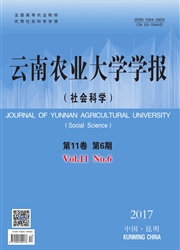

 中文摘要:
中文摘要:
通过田间试验,研究了不同施氮水平(N0:0kg/hm2,N1:125kg/hm2,N2:250kg/hm2,N3:375kg/hm2)对玉米//马铃薯间作不同生育期根际土壤酶活性和硝化势的影响。结果表明:与单作相比,玉米//马铃薯间作提高了玉米和马铃薯根际土壤脲酶、蛋白酶及过氧化氢酶的活性,也促进了土壤的硝化作用;随着施氮量的增加,在玉米拔节期(马铃薯现蕾期),间作玉米及间作马铃薯根际土壤脲酶活性、硝化势呈上升的趋势,并在N3处理达到最大值,蛋白酶、过氧化氢酶活性则呈先增后降的趋势,并在N2处理的活性最高;在成熟期,根际土壤脲酶、蛋白酶、过氧化氢酶活性均在N2处理的活性最高,而土壤硝化势则在N3处理达到最大值;相关性分析结果显示,土壤硝化势与土壤酶活性之间呈显著或极显著的正相关关系。说明施氮及间作种植对土壤酶活性和土壤硝化势的提高均具有积极作用。
 英文摘要:
英文摘要:
Field trials were carried out to investigate the effects of different nitrogen application rates (0, 125, 250 and 375 kg/hma) on rhizosphere soil enzyme activity and potential nitrification in maize//potato intercropping ecosystem. The results indicated that compared with monocropping, inter- cropping increased the activity of urease, protease and catalase, and promoted the soil nitrification. The enzyme activities and the potential nitrification in rhizosphere soil of maize and potato in intercrop- ping increased with the increase of nitrogen application rates and peaked at N3 treatment, and the pro- tease, catalase activities increased with the increase of nitrogen application rate and the highest incre- ment was with N2 treatment at the jointing stage ( squaring stage) ; the urease, protease, catalase activ- ities in rhizosphere soil of maize and potato in intercropping increased with the increase of nitrogen ap-plication rate and peaked at N2 treatment, the potential nitrification increased with the increase of nitro- gen application rate and the highest increment was with N3 treatment at the maturing stage. The result of correlation analysis revealed that the soil enzyme activity was significantly and markedly significantly related to soil potential nitrification. It is indicated that applying N and intereropping have a positive effect on the improvement of the soil enzyme activities and soil potential nitrification.
 同期刊论文项目
同期刊论文项目
 同项目期刊论文
同项目期刊论文
 期刊信息
期刊信息
